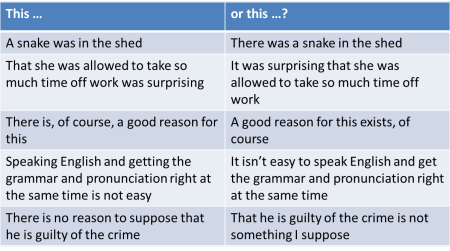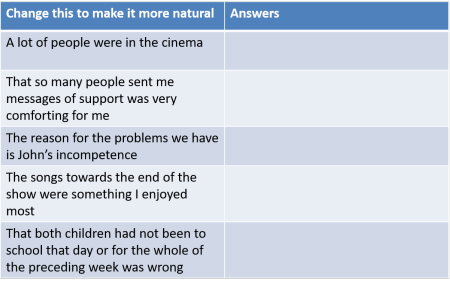Existential there and anticipatory or dummy it

Do your learners produce unnatural utterances like these?
- A fire was in the house.
- A seat was empty.
- The seat was the only empty one.
- Learning fluent French by working and living in the country is not difficult.
- Noisy children were in the garden.
- That he will be late is possible.
- A bank is on the corner.
- A knife is on the table.
- The weather will be snowy later.
If they do, it may be because you haven't focused them on existential
sentences or the use of anticipatory or dummy subjects.
All the examples above can be more naturally formed using either the
existential there or the dummy it formulation.
Try doing it or click
here to see how that works.
- There was a fire in the house.
- There was an empty seat.
- It was the only empty seat.
- It is not difficult to learn fluent French by working and living in the country.
- There were some noisy children in the garden.
- It is possible he will be late.
- There is a bank on the corner.
- There is a knife on the table.
- It will be snowy later.
In all the cases above, the more natural sentences are formed
with the existential there or with a dummy it
taking the subject position.
In all cases, too, the subject grammatically is there or
it but the notional (or semantic, if you
prefer) subject is the noun which would otherwise form the
grammatical subject, too.
 |
(In)definiteness |
There are two points to notice concerning definiteness:
- We use the existential there when the noun itself
is indefinite. So, instead of the awkward and unnatural:
Some sugar is in the cupboard
A bus is on the corner
we deploy the existential there to get:
There is some sugar in the cupboard
and
There is a bus on the corner. - The dummy it is more frequently used when the noun
which it anticipates is definite so we get, for example:
The car was green
converted to:
It was a green car
and
The house was empty and cold
converted to:
It was a cold, empty house.
By the way, there are many alternative descriptions of what we
are calling the dummy pronoun here. You may see them called an
expletive pronoun, a preparatory pronoun or a pleonastic pronoun
(pleonastic just means redundant or unnecessary).
Those expressions suggest that the forms are there to fulfil the
requirements of English grammar rather than adding any meaning to
the sentence and that is true. In this sense, both the
existential there and and the dummy or anticipatory it
are frequently simply slot fillers which make a clause conform the iron
rule (in English) of ensuring that verbs have subjects.
Some analyses, including most of this guide, distinguish between
it used as a prop-form (which simply makes a clause conform
to the grammar of English) and an anticipatory form which does stand
for a recognisable item so, for example:
It is raining
is an example of the word it used as a prop-form
because English syntax requires a subject in declarative clauses.
The word does not stand for anything identifiable. However,
in:
It was nice to be asked
we can see that the use of it is anticipatory and
stands for the non-finite clause so the sentence may be rephrased
as:
To be asked was nice.
 |
Two complementary principles |
There are two principles at work here which combine to determine the normal or canonical ordering of factual information clauses.
 |
The end-weight principle |
There is a clear tendency in English to place longer and more complex
phrases towards the end of sentences rather than at the beginning.
The key concept here is heaviness. The longer and more complex a
constituent of a clause is, the heavier it is said to be.
For example, modifying a noun with a single adjective as in:
The red car
is a very light way to do so and the tendency in English is to place
light elements such as adjectives, numerals and other determiners before
the noun. That's why, in English, we get:
three cars
not
cars three
(as we do in some other languages, including Yoruba and many
African languages as well as Thai and many other South-East Asian
languages).
On the other hand, heavier elements tend to follow what they modify so
we have, e.g.:
The car which I drove for many years when I was a
student
Here is an example of how heaviness affects how natural-sounding a sentence is. Read the following aloud and decide which to you seems the most natural, normal way to order the items in the sentence. Then click here:
- The problem was John's complete and absolute denial that there was something seriously wrong with the car.
- John's complete and absolute denial that there was something seriously wrong with the car was the problem.
Which of them sounded more natural to you?
If you chose
sentence 1., you are in the majority.
Sentence 2. flouts the
end-weight rule by placing the heavy (i.e., more complex) expression at
the beginning. The end-weight principle accounts for a great deal
of word ordering in English which is otherwise not easily explained.
 |
The end-focus or old-before-new principle |
The other principle at work in English is the fact that new information is placed towards the end of sentences. Here's a very clear example (from Bruno, no date):
- Every Tuesday, Samantha takes her dog to the dog park near her house. The city of San José maintains the dog park in an effort to promote healthy lifestyles. The city of San José sustains several dog parks throughout the city.
- Every Tuesday, Samantha takes her dog to the dog park nearby her house. The dog park is maintained in an effort to promote healthy lifestyles by the city of San José. The city of San José sustains several dog parks throughout the city.
It is easy to see that 4. flows more easily than 3. because the reader is led through the three sentences by reference to old information before the introduction of new information. This is an example of theme-rheme structuring. (For more, go to the guide the theme-rheme structure, linked in the list at the end of related guides.)
 |
So what? |
Taken together, the end-weight and end-focus principles have a powerful effect on word order in English, even though the language is often said to have a very firmly fixed word order. The effect is twofold:
- Extrapositioning:
The notional subject of the verb is moved towards the end of the clause, a phenomenon known as postponement, so instead of:
The fire did the damage
we might have
It was the fire that did the damage
and instead of
Some children were damaging the garden
we might have
There were some children damaging the garden - Fronting:
An anticipatory or dummy subject fronts the sentence but, unlike most cases of fronting, this is in fact the unmarked rather than marked form in English (and that is not so in many languages). For example, fronting an adverb usually marks it in some way for special emphasis, so the difference between:
Yesterday, I went shopping
and
I went shopping yesterday
is that in the first case the time is marked as especially important and in the second, it is not.
However, this is not the case for anticipatory there and it clauses so
There is a snake in the garden
is the normal, unmarked, way of stating a fact in English
but
A snake is in the garden
is less common and therefore more strongly marked.
The resulting sentence with the introductory or existential There
... contains two subjects: the noun phrase which is
what we would normally expect to be the subject of the verb and the
anticipatory subject, there or it.
This means that we have two subjects for a single verb and, because they
refer to the same entity, they can be said to be in apposition.
A second reason for focusing on this area in our teaching is that it
is by no means straightforward, as we shall see and avoiding errors such
as:
*Anything can't be wrong
*To learn a new language is fun
etc.
is mostly a matter of knowing how anticipatory, dummy subjects are used
in English and being aware of the fact that this is the
normal way of stating facts.
That may be in contradistinction to the way in which the learners' first
languages operate.
 |
Grammatical function and meaning |
We saw above that the formation of it and there sentences relates to the idea of end focus in English.
Grammatically, both there and it function as
the subject of the sentence in which they appear so, for example,
in:
It is difficult to learn how to do this
the pronoun it is the subject of the verb but the real,
understood subject is the nominalised non-finite verb phrase to
learn how to do this. We can see that when the sentence
is rephrased as
To learn how to do this is difficult.
Equally in, e.g.:
There is a dog in the garden
we can see that grammatically, there is the subject of the
verb be but semantically we know that a dog is the
subject of the verb and the sentence can be rephrased to show this
as:
A dog is in the garden.
In terms of meaning, the two types of sentence are distinct:
- Sentences with a fronted there is / there are
clause refer to the existence of something so, e.g.:
There is a storm coming
refers to the existence of a storm, not its nature.
Hence the term for such sentences is existential. - Sentences using the fronted it + be are
different and there are two types. It is quite important
to distinguish between them because the function of the pronoun
is quite different:
- In some such clauses, the focus is on the nature of the
real subject, not its existence per se. Thus
in, e.g.:
It is wonderful to hear your news
the focus is on the attribute wonderful as it applies to the news not on the existence of the news as such. The sentence could be rephrased as:
To hear your news is wonderful
which shows that the pronoun does in fact have a real referent.
In, e.g.:
It doesn't matter what he says
It is possible that I will have to work late
the focus is on the fact that what he says (the real subject) is not of importance in the first example and on the fact that my having to work late (the real subject) is a possibility.
Both sentences can be rephrased as:
What he says doesn't matter
That I will have to work late is possible
In these kinds of sentence the function of it is to anticipate the real subject of the sentence; hence the name anticipatory. The real subject is postponed to conform to end focus.
The anticipatory nature of some it-clauses shows up particularly with cleft sentences (to which there is a separate guide, linked below) as in, for example:
It was to a restaurant that they were invited
It was them who were invited to a restaurant
etc. which serve to mark the adverbial and the pronoun respectively for emphasis but we know what the real subject of both clauses is. - Other it-fronted sentences are those in which
there is no real or imagined subject at all and this
accounts for the name we give to them: dummy-it
clauses. We can also call them empty
it-clauses,
non-referential it-clauses, prop it-clauses or even ambient
it-clauses.
In these cases, we have what is called a non-referential use of the pronoun because there is no referent to which it can refer. For example:
It's early
It's raining
It's time to go
and in no case can we retrieve a noun phrase for which the pronoun may be said to stand.
- In some such clauses, the focus is on the nature of the
real subject, not its existence per se. Thus
in, e.g.:
- Certain (pseudo-) copular verbs are routinely used with
a dummy it-subject as in, for example:
It appears she's not coming
It seems he's been sacked
It's growing dark
etc. - The dummy it construction is also preferred when a
finite clause is raised to the patient position in a passive
sentence so, for example, although:
That he was late was noticed by the boss
is grammatically acceptable, it is stylistically dispreferred and the preferred option is:
It was noticed by the boss that he was late. - A common passive form in English also requires the use of
the dummy it so we get, for example:
It is said that he is rather wealthy
It was not considered advisable to do it that way
in which the referent for the pronoun is difficult to identify although it may be something like people or the company.
 |
Existential there clauses |
Compare these two sentences:
- There is something rather strange and frightening about him.
- Something strange and frightening is about him.
Sentence 6. sounds strange even though it is grammatically correct. What English does here, to comply with the end-weight principle, is to insert a dummy subject and allow the noun phrase to be shifted to the end of the sentence. Unsurprisingly, this is called 'shifting' in the literature.
Here are some more examples of the ways English can use the dummy or existential there:
- There can't be anything very wrong.
- There was someone playing the piano in the house.
- There are good reasons for the problem.
- There have been some nasty incidents recently.
- There's a man with a dog in the garden.
Now try to alter the sentences to avoid the existential there and see what you get. Click here when you have done that.
If you try to alter those sentences to
avoid the dummy there, you get rather odd and
unacceptably foreign-sounding results like:
*Anything can't be wrong
?Someone playing the piano was in the house
*The problem has good
reasons
*Nasty incidents have been recently
?A man with a dog is in the
garden.
Frequently, it is difficult to identify exactly what is wrong with a
learner's production because it 'just sounds wrong'. Avoidance of
the existential there clause is often the reason.
The other source of error with existential there sentences is
to neglect to note (or be told) that the subject must be indefinite.
For example:
We can have:
There's a girl in the classroom
but not:
*There's the girl in the classroom
unless the word there is an adverb of place telling us not that the girl
exists but where she is
and
There's something I want to ask
but not
*There's that question I want to ask
(Note, however, that informally a definite noun phrase as the
subject is allowed:
There's my feelings to consider
There's Mrs Smith who needs inviting.)
Concord with the existential there
Usually, in informal English, we assume that the dummy there is singular. This is not permitted in very formal English or anywhere near a grammar pedant. We can, therefore, have both:
- There's two men coming up the path.
- There are two men coming up the path.
The reason for this slight ambiguity is that,
grammatically, there is
the subject of the sentence but the subject of the 'normal' clause is
notionally still the subject of the
verb so both verb forms are allowable.
We could not have:
*Two men is coming up the path
because that clearly breaks the rules of concord in English but when we
rephrase with the existential there-clause, a singular verb
form is often the choice.
Strictly speaking, there is precedes a singular or mass noun
phrase and there are precedes a plural but concord in BrE, in
particular, is a mess and we often encounter, for example:
There's good reasons for his behaviour
and so on.
For more, see the guide to concord, linked below.
Relative pronoun clauses with existential there
This is a frequent pattern in English. For example
- There's nothing more (that) I want to see.
- There's nothing (which) interests me here.
(In both these examples it is possible to omit the relative that or which.
That is not possible in other relative clauses because it is the subject
of the verb. We cannot, therefore, allow:
There's a man wants to see the manager
because the man is now the subject of the relative clause and
the pronoun cannot be ellipted.)
Other verbs with the existential there
The existential there is almost exclusively used with a form
of the verb be.
Up to now we have only been using there with the verb be
but there are other verbs which can be used. The copular verbs
seem and appear are obvious candidates but others are possible.
- There stood a suspicious-looking man on the corner.
- There appears to be a mistake in the figures
- There comes a time when I have simply to give up.
Uses like these are mostly literary and in 18., the first clause has become a semi-fixed expression.
 |
How many sorts of there clauses? |
Quirk et al (1972) identify six sorts of existential there sentence
forms. Others, e.g., Chalker (1984), refer to there used
this way as the introductory there without setting out the
possibilities in any detail and others, e.g., Parrott (2000) refer
to it as a dummy subject, again without setting out the
details. We'll follow the first of these in this list but reduce
the list to two main sorts, putting together related formulations
(because that's the way to teach them). The essential differences
are down to transitivity in English verbs.
This is not a teaching syllabus, of course, but teachers need to be
aware of the types of sentences in which the anticipatory, dummy or existential there occurs in
English because these are not parallelled across all languages and
present learners with some difficulties.
- Intransitive verbs
- There is / are + Subject + Verb
The normal (non-fronted) sentence of this pattern is, for example:
My mother is shopping
but the pattern can be followed with an existential there clause, as in, for example:- There was a man waiting
- There was no-one looking
- Was there anyone coming?
- There is / are + Subject + Verb + Adverbial
The normal (non-fronted) sentence of this pattern is, for example:
My mother is shopping in the town centre
but the pattern can be followed with an existential there clause, as in, for example:- There was a frog in the pool
- There was nobody about
- Were there any people there?
- There is / are + Verb + Subject
Complement
The normal (non-fronted) sentence of this pattern is, for example:
My mother is unhappy about the weather
but the pattern can be followed with an existential there clause, as in, for example:- There is something unusual in the corner
- There isn't anything suspicious here
- Is there something wrong with her?
- There is / are + Subject + Verb
- Transitive verbs
- There is / are + Subject + Verb + Object
The normal (non-fronted) sentence of this pattern is, for example:
A student is asking questions
but the pattern can be followed with an existential there clause, as in, for example:- There are three people asking questions
- There aren't any people eating the food
- Is there anyone ringing the bell?
- There is / are + Subject + Verb + Object +
Adverbial
The normal (non-fronted) sentence of this pattern is, for example:
My mother is buying a new watch from that shop
but the pattern can be followed with an existential there clause, as in, for example:- There is someone making a noise outside
- There were some children cleaning the playground up
- There have been lots of people photographing the lions in the zoo
- There is / are + Subject + Verb + Object complement
The normal (non-fronted) sentence of this pattern is, for example:
The sailors are pulling the mooring ropes tight
but the pattern can be followed with an existential there clause, as in, for example:- There have been two men been making the garden tidy
- There will be police here to make the road safe for pedestrians
- There is a blacksmith making the horseshoes red hot
- There is / are + Subject + Verb + Indirect Object + Direct
Object
The normal (non-fronted) sentence of this pattern is, for example:
My mother is buying me a present
but the pattern can be followed with an existential there clause, as in, for example:- There is someone making the kitchen a mess
- There is someone reading the children a story
- Is there anyone giving you problems?
- There is / are + Subject + Verb + Object
Adverbials and complements can, in fact, be tacked on to all the forms so we might get, for example:
- There is something unusual here
- There are three people asking questions loudly
- There hasn't any work being done on it yet
- There isn't anything in the cupboard to give the children to eat
There are, somewhat more rarely, passive possibilities with the existential there. For example:
- There will be no stone left unturned
- There have been four windows broken
 |
it as a dummy or anticipatory subject |
The principles of end focus (old before new) and end weight are at work here, too.
The pronoun it can stand for complete clauses and is often
used in this way to allow us to shift the clause itself to the end.
This is why it is called the anticipatory it. The pronoun
anticipates what it stands for (often a nominalised clause).
We can convert a sentence with a nominalised clause to one with an
anticipatory it-subject like this:
To leave the party early was a mistake
becomes:
It was a mistake to leave the party early.
Try doing it in these examples and then click here.
- To leave India without seeing the Taj Mahal is crazy.
- That he is such a good cook is surprising.
- What I do or say to her doesn't make a difference.
- To hear him talking so rudely and callously shocked me.
More natural formulations might be:
- It is crazy to leave India without seeing the Taj Mahal.
- It is surprising that he is such a good cook.
- It doesn't make a difference what I do or say to her.
- It shocked me to hear him talking so rudely and callously.
The anticipatory it can also stand for a range of nominalised phrases and clauses as in, e.g.:
- adjective plus non-finite to-infinitive
- It is wonderful to
see her
It is a delight to watch
It's fun to try
It is a shame to miss the concert
It is a pity to lose the money
It is odd to forget them - adjective plus non-finite -ing clause
- It is lovely being here
It is horrible going shopping with her
It was nasty walking in the rain - nominalised finite that-clauses
- It is odd that she isn't here
It is a pity that she can't come
It is a shame that he's away
It as a dummy subject with no discernible meaning is used as the subject or object of many statements about weather, time, place and condition as well as some semi-fixed expressions. For example:
- It is raining
- It is Wednesday
- It would be nice if you helped
This use is referred to as the non-referential use
of it for a rather obvious reason: we cannot, in fact, identify
the referent at all.
Fort a little more in this area, see the
guide to nominal clauses, linked from the list at the end, in which the clause as the object or
subject of a verb is discussed.
 |
it as a dummy object |
So far, we have considered the role of it as a dummy
subject of the verb but, on a rather ad hoc basis, English
can use a dummy it as the object of a verb or even a
prepositional complement / object. Again, in these senses, it
is very difficult to assign a referent to the pronoun (although it
is sometimes possible to infer it).
For example, in expressions such as:
Go for it!
He'd made it in life before he was out of his twenties
I don't get it at all
I'm afraid I blew it
I don't feel very with it today
I asked but she seemed a bit out of it at the time
I can't take it any more
all the uses of it are either as a dummy object of a verb
or a dummy complement object in a prepositional phrase.
 |
Pronunciation |
Both it and there are function words rather
than containing any recognisable content and, in common with most
function words, are susceptible to a good deal of weakening and
reduction in connected speech.
In fact, both items are often so reduced that they are barely
noticeable and that represents both a comprehension and production
problem for some learners who, having not heard the items, may well
not realise the importance of using them.
If, for example, we say:
It's silly to do that
the pronunciation may well be:
/ˈsɪ.li.tə.duː.ðæt/
with no sounding of the anticipatory it's at all because
the pronoun is elided and so is the verb by a process of adjacent
sound elision because of the /s/ at the start of silly.
Even
if it is sounded in some fashion, it is unlikely to be more
noticeable than the opening /ə/ in:
/ˈəsɪ.li.tə.duː.ðæt/
The 't' in the word is almost never sounded in connected speech.
Even when we say:
It's a pity
in which there are no adjacent sounds the pronunciation may well be:
/sə.ˈpɪ.ti/
rather than
/ɪts.ə.ˈpɪ.ti/
as one would get in citation mode or very careful and formal speech.
The word there also suffers the same fate but is not
elided altogether even in very rapid speech.
If we say:
There's a pub on the corner
the usual transcription of even quite slow speech would be:
/ðez.ə.pʌb.ɒn.ðə.ˈkɔː.nə/
rather than the careful
/ðeəz.ə.pʌb.ɒn.ðə.ˈkɔː.nə/
Even in very careful speech, the 'r' in the word is unlikely to be
sounded by a BrE speaker but in AmE the transcription may well be:
/ˈðerz.ə.ˈpəb.ɑːn.ðə.ˈkɔːr.nər/.
(Note here that we are talking about there as a dummy subject,
not there as an adverb. When the word is an adverb it is
usually stressed:
There's John!
Please sit
there
and given its full form as /ðeə/, but when used as a dummy, it is unstressed:
There's a bank on the corner.
and often contains a weakened vowel so the first two words in the
last sentence are pronounced as /ðəz/ rather than /ðeəz/.)
 |
A note about other languages and teaching this area |
Very few languages handle this area in the same way that English
does. Few languages are as obsessed as English is with inserting a
dummy subject and in those languages, the subject is often simply
omitted, so you'll get errors such as
*I don't like when you call me
stupid
*I think is probable they will win etc.
Usually errors like this arise because the learner's first
language is a so-called pro-drop language.
In Italian, for example:
I am unhappy
translates as:
Sono triste
with no pronoun before the verb. Spanish, Catalan,
Russian, Romanian, Greek and a range of other languages routinely
omit the pronoun because the verb form signals the person and the
pronoun is redundant. Other languages, such as French,
Portuguese, German and Swedish are, like English, non-pro-drop
languages.
The result is that people whose first languages are pro-drop will
often produce:
*Is difficult
*Was nice
*Will be fun
etc. because that is how the clauses will translate directly.
So, for example:
It is difficult
translates as:
Eínai dýskolo (Greek)
Es difícil (Spanish)
È difficile (Italian)
Este dificil (Romanian)
etc.
Even if they do use a dummy it (as some do) speakers of many
languages will probably
not use an existential form such as there.
For example,
There is a mouse in the house
might in other
languages be
It has a mouse in the house
It gives a mouse in the house
The
house has a mouse
It exists a mouse in the house
It finds a mouse in
the house
and so on.
Language such as Greek and Romanian which do not have a dummy subject of
any kind will often use a verb meaning exist so, directly
translating, speakers of those languages might produce
Exists a
mouse in the house.
Careful attention and alertness to your learners' production in this area pays dividends in terms of their being able to produce more natural sounding and less foreign utterances.
 |
Awareness raising of the principles of end focus and end weight
|
It is probably worth a bit of classroom time to raise your learners' awareness of these two fundamental principles because they underlie so much which is otherwise hard to explain.
A straightforward way to start the process is to present the learners
with sentences which conform to the principles, contrasted with some
that don't but express the same meaning. For example, which of the
following are the most natural formulations? Click on the table
when you have an answer.

From there, it's a short step to getting learners to be able to
reformulate sentences more naturally as in this example. Click on
the table when you have the answer in your head.

| Related guides | |
| the word order map | for links to other guides in this area |
| cleft sentences | explaining how we get from, e.g., She liked the hotel to It was the hotel she liked |
| concord | for the guide to an extremely messy and variable grammatical area in British English in particular |
| word ordering | for a guide to canonical and marked word ordering in English |
| fronting | for an analysis of how items may be marked and moved to the beginning of clauses |
| nominalised clauses | clauses acting as noun phrases are often the referent for the anticipatory it discussed above |
| theme and rheme | for more on how the anticipatory and existential uses of it and there form the themes |
| postponement and extrapositioning | which explains how and why items can be moved to the end of a clause or sentence |
References:
Bruno, C, n.d., Old Information before New Information, San
José State University Writing Center, at
http://www.sjsu.edu/writingcenter/ [accessed February 2015]
Chalker, S, 1984, Current English Grammar, Basingstoke:
Macmillan
Croft, W, 1990, Typology and Universals, Cambridge: Cambridge
University Press
Parrott, M, 2000, Grammar for English Language Teachers (2nd
Edition), Cambridge: Cambridge University Press
Quirk, R, Greenbaum, S, Leech, G & Svartvik, J, 1972, A Grammar of
Contemporary English,
Harlow: Longman
